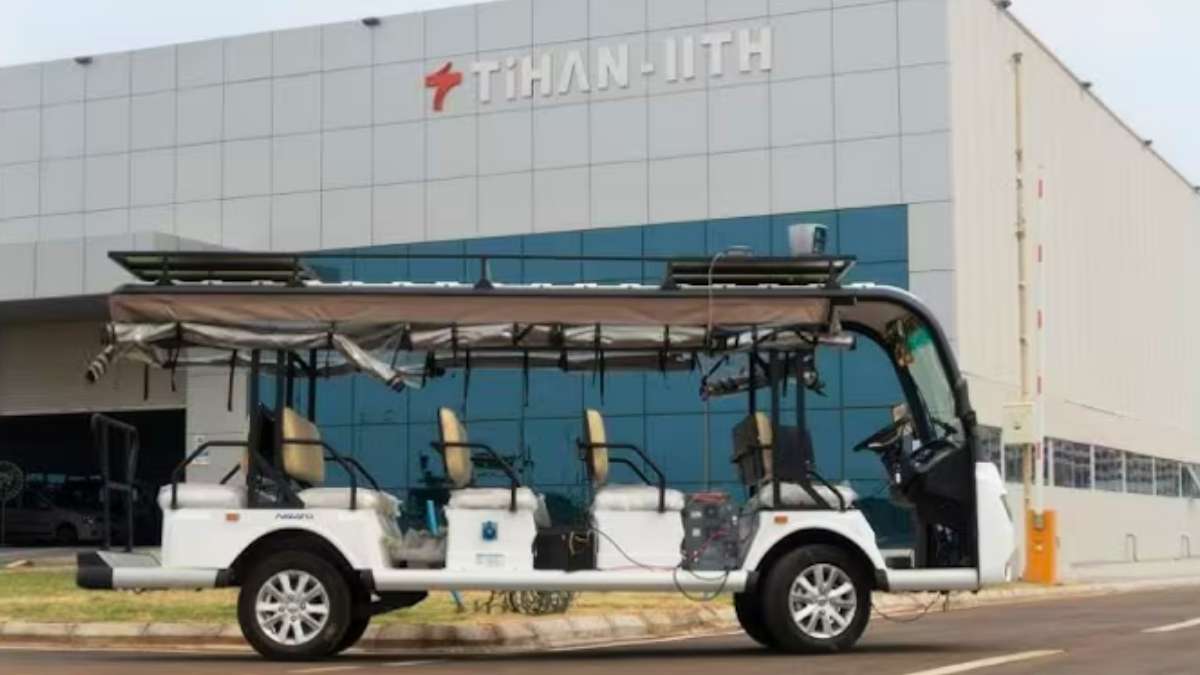
IIT Hyderabad’s TiHAN: Pioneering India’s Autonomous Future with Self-Driving Buses
India’s transport scene is changing. IIT Hyderabad’s TiHAN, which stands for Technology Innovation Hub for Autonomous Navigation, has launched something truly new. They have put India’s first AI-powered driverless electric buses into service. This is a huge step for how people will move around in the future.
This move is big for transportation across India. It promises safer, more efficient, and cleaner ways to travel. These buses have already proven themselves, logging over 10,000 safe rides. What’s more, passengers gave them over 90% positive feedback. This shows a clear path toward smart, self-driving public transport.
What is TiHAN at IIT Hyderabad?
TiHAN is a special center at IIT Hyderabad. It was set up to be a national hub for tech related to autonomous navigation. Its main goal is to push new ideas in this field. TiHAN helps researchers and companies work together. They aim to create new products and systems for a self-driving future.
The Driving Force Behind Autonomous Buses
Developing these autonomous buses took a lot of teamwork. IIT Hyderabad worked closely with many industry partners. The Indian government also supported the project with its initiatives. This big effort brought the vision of driverless transport to life.
Technological Marvel: The Driverless Electric Buses
AI and Sensor Fusion for Navigation
These driverless electric buses use very smart AI. They rely on many sensors to “see” the world around them. LiDAR, radar, and cameras work together, like a bus’s eyes and ears. These systems help the buses know exactly where they are. They also help plan safe routes and avoid anything in their path.
Electric Powertrain and Sustainability
The buses run purely on electricity. This means they are good for the environment. They do not produce any harmful exhaust. Electric buses also cost less to run over time. They mark a real commitment to clean energy transport.
Safety Features and Redundancy Systems
Safety is built into every part of these autonomous buses. They have many backup systems. If one part fails, another takes over right away. This design makes sure passengers stay safe at all times. The 10,000 safe rides milestone proves how well these safety systems work.
Real-World Impact and Performance
Navigating the IIT Hyderabad Campus
The buses run within the IIT Hyderabad campus. This environment acts as a living lab. They handle campus roads and various traffic conditions with ease. These trials show how reliable they are in a real setting.
User Feedback and Acceptance
People who rode the buses gave great reviews. Over 90% of riders had a good experience. Passengers often spoke about the smooth ride. They also felt safe and comfortable on board. This positive feedback is key for wider public trust.
Challenges and Learnings from Field Trials
Building and running these buses was not without its hurdles. Engineers learned a lot during testing. They used these lessons to make the buses even better. Every challenge helped improve the system’s smarts and safety.
The Broader Implications for India
Revolutionizing Public Transportation
Imagine a future where city buses drive themselves. This technology can change public transport in Indian cities. It can make trips faster and more organized. It also helps cut down on traffic jams. Such systems make travel easier for everyone.
Economic and Societal Benefits
This new tech can open up many job opportunities. These might be in software, engineering, or maintenance. It also makes roads safer for everyone. Better travel options can improve life in many ways for society.
Paving the Way for Future Autonomous Systems
The driverless buses are just the start. They set a path for other self-driving tech. Think about robots for deliveries or smart systems for farming. This work helps India move closer to a truly autonomous future.
The Road Ahead: Future Developments and Integration
Scaling Up and Wider Deployment
Can these buses run in more places? There’s potential for them to serve other college campuses. They could also operate in smart city areas. Even bigger public transport networks might use them someday.
Regulatory Framework and Policy Support
New rules are needed for self-driving cars and buses. The government must create policies to support this technology. Clear laws will help autonomous vehicles join our daily lives smoothly. These rules ensure safety and guide how the tech is used.
Continuous Improvement and Research
IIT Hyderabad keeps working on this technology. Their research aims to make autonomous driving even better. They want to boost system smarts and ensure top safety. The work does not stop; it moves forward always.
Conclusion: Driving India Towards an Autonomous Future
IIT Hyderabad’s TiHAN project has made a big mark. The success of its self-driving buses shows India’s readiness for new tech. These AI-powered vehicles offer a glimpse into safer, cleaner, and more efficient travel. They are not just buses; they are a sign of progress.
Autonomous mobility holds great promise for India. Continued investment and new ideas are vital. They will help shape a future where smart transport benefits us all.



